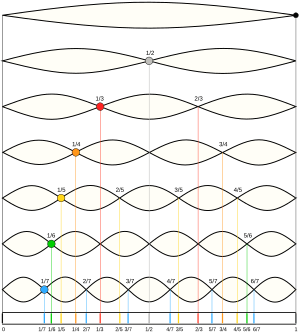Harmonic facts for kids
A harmonic of a wave is the part of a signal's frequency that is a whole multiple (an integer) of the fundamental frequency. The fundamental frequency is the lowest frequency of a periodic waveform. If f is the fundamental frequency (that is, 1f), then the harmonics have frequencies 2f, 3f, 4f..., and so on. The second harmonic (2f) has a frequency twice that of the fundamental frequency, the third harmonic three times, and so on. This concept applies to wave motions of any form of energy, but is perhaps most often related to acoustics.
Frequencies that lie between one harmonic and another harmonic are called interharmonics. For example, 1⅓f is an interharmonic between the fundamental frequency (or first harmonic) and the second harmonic. Interharmonics is a term invented, or at least standardised, by the international electronics industry about 1999, particularly for use in electrical energy. However, interharmonic frequencies also occur naturally in other radiant energies, for example music or any type of sound.
Related pages
Images for kids
See also
 In Spanish: Armónico para niños
In Spanish: Armónico para niños



